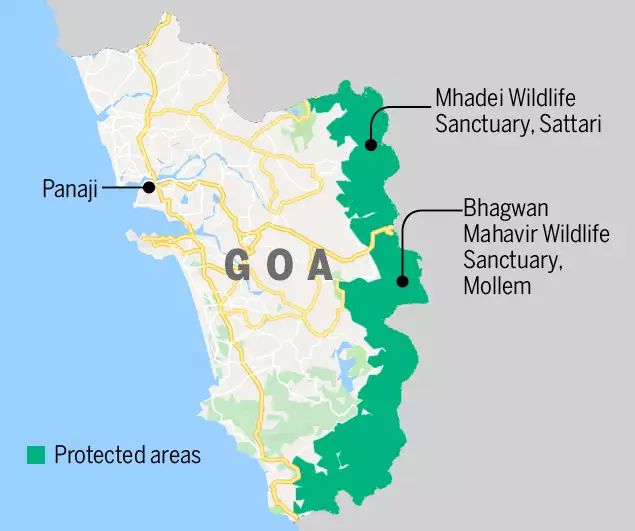Mhadei Wildlife Sanctuary
Mhadei Wildlife Sanctuary, also known as the Bhagwan Mahavir Wildlife Sanctuary, is located in the Western Ghats of Goa, India. It is situated in the northeastern part of the state and covers an area of approximately 208 square kilometers. The sanctuary was established to protect the rich biodiversity and unique ecosystems found in this region.
Formation of Bhagwan Mahavir Wildlife Sanctuary:
The Bhagwan Mahavir Wildlife Sanctuary, which includes the Mhadei Wildlife Sanctuary, was officially established in 1978. The sanctuary was named after Lord Mahavir, a revered figure in Jainism. It was created with the aim of conserving the diverse flora and fauna of the Western Ghats and ensuring the long-term sustainability of the region’s ecosystems.

information about Mhadei Wildlife Sanctuary:
Biodiversity:
The sanctuary is renowned for its diverse flora and fauna. It is home to a wide range of species including various mammals, birds, reptiles, and amphibians. Some of the species found here are the Indian bison (gaurs), spotted deer, sambar deer, wild boar, Malabar giant squirrel, Indian pangolin, and various species of monkeys.
Avian Diversity:
The sanctuary is a haven for birdwatchers, as it hosts a variety of bird species. Some of the notable birds found in Mhadei Wildlife Sanctuary include the Malabar pied hornbill, grey junglefowl, heart-spotted woodpecker, and various species of kingfishers and bulbuls.
Flora:
The sanctuary boasts a diverse range of plant species due to its location in the Western Ghats. You can find evergreen and semi-evergreen forests, deciduous forests, and grasslands. A variety of plant species, including medicinal plants and endemic flora, contribute to the rich biodiversity.
Threatened Species:
The Mhadei Wildlife Sanctuary provides habitat for several species listed as vulnerable, endangered, or critically endangered on the IUCN Red List, such as the Indian pangolin.
Importance of Conservation:
The sanctuary plays a crucial role in conserving the unique ecosystems of the Western Ghats, which are recognized as a global biodiversity hotspot. It helps protect the natural habitats, maintain ecological balance, and provide a safe haven for many species.
Trekking and Eco-Tourism:
The sanctuary offers opportunities for eco-tourism and nature-based activities such as trekking, birdwatching, and wildlife photography. Proper regulations are in place to ensure that tourism activities do not harm the delicate ecosystem.
Access:
Mhadei Wildlife Sanctuary is accessible from various entry points in Goa, and guided tours are available for visitors who wish to explore the natural beauty and biodiversity.

Threaten species in Mhadei Wildlife Sanctuary:
Mhadei Wildlife Sanctuary is home to several species that are classified as threatened or have conservation concern. These species are either vulnerable, endangered, or critically endangered according to the International Union for Conservation of Nature (IUCN) Red List. Please note that the status of these species may have changed. Some of the threatened species that may be found in the sanctuary include:
Indian Pangolin (Manis crassicaudata):
This species is listed as Endangered on the IUCN Red List. Pangolins are small, scaly mammals that are highly sought after for their scales and meat, making them one of the most trafficked animals in the world.
Malabar Large-spotted Civet (Viverra civettina):
This civet species is listed as Vulnerable. It is a medium-sized carnivore that is primarily nocturnal and inhabits forests.
Gaur (Bos gaurus):
Also known as the Indian bison, the gaur is listed as Vulnerable. It is the largest bovine species and is found in forests and grasslands.
Nilgiri Marten (Martes gwatkinsii):
This elusive carnivore is listed as Vulnerable. It is found in the Western Ghats region and is known for its arboreal and semi-arboreal habits.
Malabar Pied Hornbill (Anthracoceros coronatus):
This bird species is listed as Near Threatened. It is a large, colorful hornbill found in the Western Ghats and adjacent areas.
Indian Giant Squirrel (Ratufa indica):
This squirrel species is listed as Near Threatened. It is known for its striking appearance and inhabits the canopies of trees in forests.
Gray Slender Loris (Loris lydekkerianus):
This primate species is listed as Vulnerable. It is a nocturnal primate with large eyes and a slender body.
Malabar Tree Toad (Pedostibes tuberculosus):
This amphibian species is listed as Vulnerable. It is a unique tree-dwelling toad found in the Western Ghats.
Indian Skimmer (Rynchops albicollis):
This bird species is listed as Vulnerable. It is known for its unique feeding behavior and is found in riverine habitats.
Nilgiri Langur (Trachypithecus johnii):
This primate species is listed as Vulnerable. It is found in the Western Ghats and is known for its distinctive black fur and white facial markings.
Designation and Expansion:
The sanctuary was initially established with the purpose of protecting the area’s biodiversity and maintaining ecological balance. It also aimed to provide a space for scientific research, education, and eco-tourism. Over time, the sanctuary’s boundaries and management practices may have evolved to better address the conservation needs of the region.
Conservation Challenges:
Like many protected areas, the Mhadei Wildlife Sanctuary has faced challenges such as habitat fragmentation, human-wildlife conflicts, and pressures from developmental activities. Conservation efforts have involved a combination of wildlife protection, habitat restoration, community engagement, and sustainable tourism practices.
Research and Study:
The sanctuary has also been a site for scientific research and studies, contributing to our understanding of the biodiversity and ecology of the Western Ghats.
Tourism and Education:
The Mhadei Wildlife Sanctuary has also played a role in eco-tourism and environmental education. It offers opportunities for visitors to appreciate the natural beauty of the region while promoting responsible tourism practices that minimize negative impacts on the ecosystem.